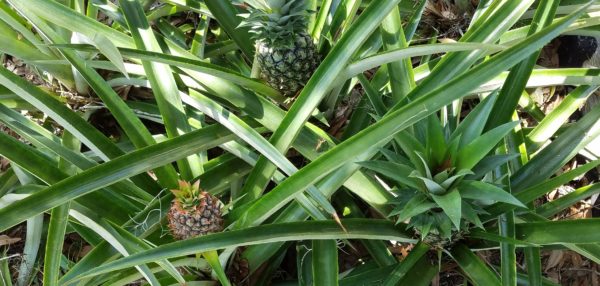When I first figured out that the huge, sharp, spiky plants that came with our house were pineapple, I went looking online for instructions and tips for growing and harvesting the plants. While I found some really helpful information, like suggestions to move the plants into the sun for better fruit production, I also found a chorus of recommendations that have proved untrue for my situation.
What is my situation? I live on the west coast of central Florida in planting zone 9. The north side of my house backs up on a lake, so there may be a little bit of a micro-climate happening that can protect the plants in my back yard from minor freezes. I have my pineapple plants in raised planting beds established by the previous owners of the house. I think the beds have a weed blocker on the bottom which means whatever I plant in there only has 8-12 inches of depth for root growth. The beds are filled with a variety of sand, enriched soil, compost and decomposing leaf mulch.

Myth # 1: you need a lot of sun
While pineapples thrive in sun and the ones that came with the house burst into action when I first moved them, I no longer think that they need full sun here in central Florida in order to be healthy and fruit on schedule. I now have a few at one end of a bed that gets pretty consistent shade all afternoon, and some of them have fruited in their first year! I exclaim because up until this year all of my pants regularly took two years to fruit. Add to this, the tendency for the developing fruit to sunburn in the heat of summer if tilted to one side, and I think at least a little shade might be beneficial.
Myth # 2: Amend your soil and fertilize
Admittedly, I have my pineapples planted in a raised bed with a healthy mix of soil and compost. However, I did not pH test, nor do I bother amending the soil on a regular basis. The most I do is spread the oak leaves I sweep up from the side of yard as mulch to help keep the weeds at bay. Pineapples are not picky; they are not fussy. They get some of their water from the air and do not wholly depend on their shallow root system.
Myth # 3: When to harvest aka pineapples don’t ripen after picking
I found several sites that confidently proclaim that pineapples don’t ripen after harvest. Along with this comes the information that color is no indicator of ripeness. Well this is all just hooey, in my opinion.
For one, I harvest my fruits before they are completely ripe and I judge ripeness on color and smell. When harvesting I cut down low on the stem and then leave the stem attached. I’ve found a fair few sites that mention this method, but the idea is that there are nutrients in the stem that the fruit continues to feed on, helping it ripen. Yes, you can eat a pineapple that is not completely yellow*, but the color in a pineapple does in fact change as the fruit ripens. (*I am speaking from experience with one type of pineapple)
I think of it like a banana, you can eat the green-ish ones but the ripest fruits are yellow. Speaking of bananas, I’ve run into instructionals on forcing a pineapple plant to fruit by using the ethylene emitting powers of a banana and wrapping the plant in plastic. I can’t comment on whether this works since I’ve never felt compelled to try. Yes, a pineapple plant can take two years from planting before it fruits. However, it doesn’t really take very long before you have a small crop where there are some plants fruiting every year, so I found it easy to be patient.
Myth # 4: The best time to plant
This myth is simply that humans can determine the best time to plant. Some suggestions I find say it is Jan-Dec, another says early fall because the continued rain and warmth will set them well. The best way to tell when it is a good time to plant is to have a plant already. My pineapples tell me when they are ready to reproduce. When the pineapples in my yard start to fruit they also start sending up little pups from within the leaves of the plant, sometimes on the stalks underneath the pineapples (which may be called slips, I think). If you don’t plant the slips when you harvest the pineapple, they are wasted since their connection to the mother plant isn’t all that strong. And if you don’t separate the pups from the mother the growth of the new plant will be stunted. So, all in all, the best time to plant is when the plant is reproducing. Often this coincides with harvest time where I live, which is around mid to late summer.

2 Comments
Is it true that you have to let the pineapple top dry before planting It and if you don’t, what happens
Hello! I have always let it dry out a bit to expose the nodes that will eventually become roots. I think the danger of not drying out the top is that it could begin to rot before it tries to root. This is also the danger if you leave any of the fleshy fruit on the top when you plant it. If you experiment, I’d love to hear how it goes.